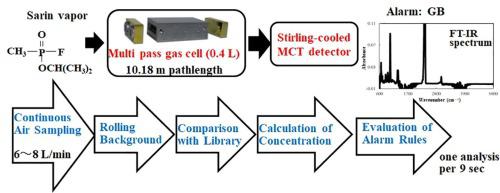当前位置:
X-MOL 学术
›
Forensic Chem.
›
论文详情
Our official English website, www.x-mol.net, welcomes your
feedback! (Note: you will need to create a separate account there.)
Continuous monitoring of chemical warfare agents in vapor using a Fourier transform infra-red spectroscopy instrument with multi pass gas cell, mercury cadmium telluride detector and rolling background algorithm
Forensic Chemistry ( IF 2.6 ) Pub Date : 2020-12-01 , DOI: 10.1016/j.forc.2020.100292 Yasuhiko Ohrui , Ryota Hashimoto , Takeshi Ohmori , Yasuo Seto , Hiroyuki Inoue , Hideki Nakagaki , Katsutoshi Yoshikawa , Larry McDermott
Forensic Chemistry ( IF 2.6 ) Pub Date : 2020-12-01 , DOI: 10.1016/j.forc.2020.100292 Yasuhiko Ohrui , Ryota Hashimoto , Takeshi Ohmori , Yasuo Seto , Hiroyuki Inoue , Hideki Nakagaki , Katsutoshi Yoshikawa , Larry McDermott

|
Abstract Identification and quantification method for chemical warfare agents (CWAs) was developed using a continuous and standalone type hazardous gas detection instrument (MKS AIRGARD® Air Analyzer), Fourier transform infra-red (FT-IR) spectroscopy system which uses a multi pass gas cell, a Stirling-cooled mercury cadmium telluride detector, and advanced data processing including an exponentially weighted moving background and chemical identification algorithm. Although FT-IR spectrum of sarin vapor prepared in ambient air included absorbance bands of carbon dioxide and water remaining due to incomplete background correction, characteristic absorbance bands were clearly observed in the fingerprint region (700–1400 cm−1) and around 2950 cm−1. n-Hexane was used not only as dissolving solvent for volatile CWAs but also as an interfering field matrix compound. The instrument provided a “GB” alarm against n-hexane (1320 mg/m3) vapor containing dilute sarin (more than 0.44 mg/m3). The height of the band peak at 1021 cm−1 increased proportionally with the concentration. Vapors of soman, tabun, cyclohexylsarin, VX and RVX, which were prepared in ambient air, provided correct alarms, and showed FT-IR spectra similar to that of sarin. The vapors of sulfur mustard, nitrogen mustard 3, Lewisite 1, cyanogen chloride and phosgene provided correct alarms with characteristic FT-IR features, which are different from those of nerve agents. The vapors of volatile CWAs except for VX and RVX provided correct alarm even in the presence of high level of n-hexane. The vapors of unregistered CWAs and mixture vapor of nerve agents were also examined.
中文翻译:

使用带有多通道气室、碲化镉汞探测器和滚动背景算法的傅立叶变换红外光谱仪连续监测蒸气中的化学战剂
摘要 化学战剂 (CWA) 的识别和量化方法是使用连续和独立型危险气体检测仪 (MKS AIRGARD® 空气分析仪)、傅立叶变换红外 (FT-IR) 光谱系统开发的,该系统使用多通道气体池、斯特林冷却碲化镉汞探测器,以及包括指数加权移动背景和化学识别算法在内的高级数据处理。尽管在环境空气中制备的沙林蒸气的 FT-IR 光谱包括由于不完全背景校正而残留的二氧化碳和水的吸收带,但在指纹区域 (700–1400 cm-1) 和 2950 cm- 附近清晰地观察到特征吸收带1. 正己烷不仅用作挥发性 CWA 的溶解溶剂,而且用作干扰场基质化合物。该仪器针对含有稀沙林(超过 0.44 mg/m3)的正己烷 (1320 mg/m3) 蒸气提供“GB”警报。1021 cm-1 处的带峰高度随浓度成比例增加。在环境空气中制备的梭曼、塔崩、环己基沙林、VX 和 RVX 的蒸气提供了正确的警报,并显示出与沙林相似的 FT-IR 光谱。硫芥、氮芥 3、路易氏剂 1、氯化氰和光气的蒸气提供了正确的警报,具有不同于神经毒剂的特征 FT-IR 特征。除了 VX 和 RVX 外,挥发性 CWA 的蒸气即使在高浓度正己烷存在的情况下也能提供正确的警报。
更新日期:2020-12-01
中文翻译:

使用带有多通道气室、碲化镉汞探测器和滚动背景算法的傅立叶变换红外光谱仪连续监测蒸气中的化学战剂
摘要 化学战剂 (CWA) 的识别和量化方法是使用连续和独立型危险气体检测仪 (MKS AIRGARD® 空气分析仪)、傅立叶变换红外 (FT-IR) 光谱系统开发的,该系统使用多通道气体池、斯特林冷却碲化镉汞探测器,以及包括指数加权移动背景和化学识别算法在内的高级数据处理。尽管在环境空气中制备的沙林蒸气的 FT-IR 光谱包括由于不完全背景校正而残留的二氧化碳和水的吸收带,但在指纹区域 (700–1400 cm-1) 和 2950 cm- 附近清晰地观察到特征吸收带1. 正己烷不仅用作挥发性 CWA 的溶解溶剂,而且用作干扰场基质化合物。该仪器针对含有稀沙林(超过 0.44 mg/m3)的正己烷 (1320 mg/m3) 蒸气提供“GB”警报。1021 cm-1 处的带峰高度随浓度成比例增加。在环境空气中制备的梭曼、塔崩、环己基沙林、VX 和 RVX 的蒸气提供了正确的警报,并显示出与沙林相似的 FT-IR 光谱。硫芥、氮芥 3、路易氏剂 1、氯化氰和光气的蒸气提供了正确的警报,具有不同于神经毒剂的特征 FT-IR 特征。除了 VX 和 RVX 外,挥发性 CWA 的蒸气即使在高浓度正己烷存在的情况下也能提供正确的警报。











































 京公网安备 11010802027423号
京公网安备 11010802027423号